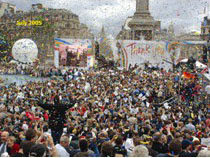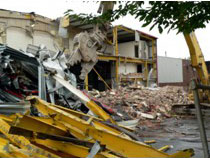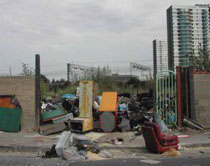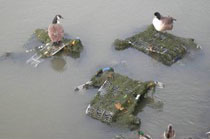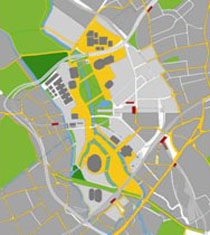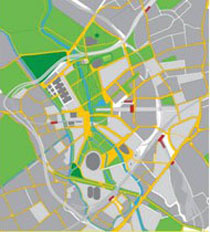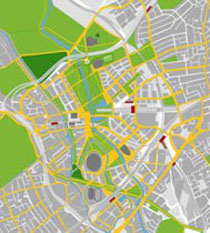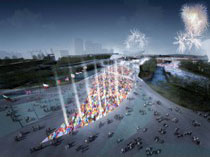
Interview with Mario Kaiser *, by Massimo Angrilli |
 |
M.A. The Olympic Park project for the 2012 Games was announced as a project-manifesto of sustainability when London bid to host the 2012 Olympic Games and Paralympic Games, the proposal committed not simply to put on the biggest sporting event in the world, but to host the world’s first truly sustainable Olympic and Paralympic Games. How has this progressed and what are the elements which underpin the project's environmental and ethical responsibility, knowing that in the past only a few similar experiences have represented any real opportunity for growth and redevelopment of areas affected.
M.K. Sustainability is generally addressed through technological solutions, the Olympic Park project instead tries to respond to the structural theme of sustainability through a fundamental choice that inspires the whole process of design and construction of the Olympic program. A choice based on a desire to see the whole plan of the Olympic Park as fallout of a more ambitious project, one that plans to redevelop one of the most neglected area of the United Kingdom, the East End, making it an area with a high quality of life, by creating a new urban zone equipped with one of the largest urban parks ever built (220 ha). This objective can be achieved only thanks to the great opportunities offered by the huge economic resources made available by exceptional events like the Olympics Games. Throughout the design process the main goal was urban and environment regeneration, even before selecting it as a suitable site for the Olympic Games. In other words, the design of the Olympic Park will be within the “essence” of the regeneration project of the Lower Lea Valley **, the master plan of which was adapted to the needs of the Games, according to a process completely opposite to what had previously been adopted for all exceptional events (Our vision is to use the power of the Games to inspire lasting change).
According to this philosophy the project’s sustainability is recognizable in the correctness of the goals set for it, that allow one to avoid a wasting of resources that normally occur in the organization of large events.
M.A. Urban and environmental regeneration of East London is therefore a crucial point of the Olympic program. What was the basis for the design choices and what are the phases into which they have been articulated?
M.K. The project is divided into three different master plans: the first one is the master plan of the Olympic Games, the second is the master plan of the so-called phase of Transition and the third is the Legacy Master Plan. The first deals with the Olympic Park and sets the times and spaces related to the holding of the games. The second deals with the transformation (transition) of the Olympic Park site into a normal urban area, with residences, offices, shops, commercial, industrial laboratories, hotels, and is managed by ODA (The Olympic Delivery Authority – the ODA is the public body responsible for developing and building the new venues and infrastructure for the Games and their use after 2012). The third master plan (the Legacy) is the true master plan of the project and has as its main goal the transformation of one of the most underdeveloped areas of the United Kingdom into a high quality green urban area. The high visibility and the availability of funds and investments guaranteed by the Olympic Games has allowed us to aim at long-term goals, constantly adapting the works planned for the games to future needs; so for example, of the 15 facilities that will be provided for the Games only four will remain useful to the future city in 2020, two of these will remain unchanged and two others will be adapted; the stadium of 80,000 spectators is oversized for the normal requirements of the city, so at the end of the event this will be reduced to a capacity of 25,000 spectators and the same will happen for the Swimming Stadium, designed by Zaha Hadid.
Each element and venue has been designed thinking of its double versions: the first to be used for the games, which will run for about a month, and the other of a work that will remain to serve the community and future generations. So for example the paths in the park have been designed both to perform their function properly during the event (to allow the movement of major pedestrian flows), and thus have a width of 40 meters, but also to carry out their future function (in the post-event) of simple paths inside the city park, when they will be reduced to a width of only 4.
Coming to the choices that were made we should say that the real project start up was the environmental cleanup of areas, in a state of serious deterioration, with soil heavily contaminated by past industrial activity. In particular, the river channel was remodelled and upgraded (cars, shopping carts and various other waste were extracted from the river). Power lines have been buried and the environmental system was generally strengthened, regenerating the green and open spaces. A large part of the available budget was assigned to this category of work. This alone shows us clearly the purpose of the initiative.
When we bid to host the 2012 Olympic Games and Paralympic Games,
We made a radical proposal to the International Olympic Committee. This
proposal was entitled "Towards a One Planet Olympics". We committed not
simply to put on the biggest sporting event in the world, but to host the
world's first truly Sustainable Olympic and Paralympic Games.
Ninety percent of the soil excavated during the works, both in remodelling the banks of channels and grounds of the park, and for the construction of the building foundations, has been re-used on site, thus minimizing the impact resulting from the movement of hundreds of trucks. This was made possible through the use of four huge machines, known as "Soil Hospitals," whose task was to wash, clean and treat all the soil and achieve an adequate degree of purity. The remaining 10% of polluted substances (a real concentration of contaminants reduced to a white powder known as “snow”) was, after the remediation process, taken to special landfills in barges.
M.A. What was the relationship between the Master Plan and the individual projects it managed, and how did the single designers relate to the overall objectives set by the ODA? In other words, were the choices influenced by the control room or was there freedom of choice?
M.K. The Olympic program set up general strategies to achieve certain objectives, for instance the percentage of energy that must come from renewable sources was fixed; the maximum amount of waste and truck traffic tolerable by the residential districts was set. So common objectives were established and quantified, and each work was required to comply with these objectives to ensure their portion, for example in terms of percentage of green energy to be generated. The designer was therefore required to comply with this set of limits, but he/she maintained a full freedom of choice as to how to achieve these objectives.
A control procedure of these objectives was exercised through periodic reviews, during which the aesthetic quality and performance level of design were verified, as well the correct achievement of objectives. In many cases the projects were halted because they did not fully meet the standards set out in the program. But the most important factor for the success of the design process was undoubtedly the positive atmosphere within the design team, inspired by the ethical principles of sustainability but also by the generous financial incentives provided by the ODA, which allowed us to build up a common strategy and good intentions which have then moved the work of all the actors and projects in the same direction.
"Inspiring change in the supply chain and creating an ethos of sustainability within the organization"
M.A. So the role played by the management process in the achievement of the desirable quality of venue designs has been decisive.
M.K. The management process has played a key role. Mainly due to "value engineering", a process whereby the end of each stage of the project design was submitted to a staff of experts, to whom was entrusted the task of evaluating the possible alternatives to the choices made by the designer that would maintain the spirit of the work while improving performance and would also meet the total cost parameters. There was therefore a continuous review of project proposals by architects, recalibrated from time to time, from preliminary ideas up to the executive design, mediating between the aspirations of the designer and the most inclusive needs of the Olympic program.
M.A. So far the debate on environmental issues does not seem to be able to affect the process of the formal and aesthetic conception of the project. Do you believe that the ethics of sustainability have also been an element of formal renewal of the architectural and urban design for the Olympic Park?
M.K. This observation takes up an essential point very well, that becomes clearer in the formal results of the projects of the Olympic Park of London 2012. Often aesthetic leads designers to move away from the goals of environmental sustainability and we frequently observe final works with inappropriate and inadequate materials used to pursue formal objectives which are ends in themselves. In the Olympic Park in all the projects appear in tonalities which are comparatively much smaller than has usually been the case for past events. The "wow factor" in projects designed in the recent past, such as Shanghai (see the stadium by Herzog & de Meuron) shifted the attention to the effect of dramatic works. A search for immediate results in terms of communication to the audience of the event.
In the case of London, the only competition on an international level, used also in the promotion of the event, was done for the Water Stadium. It was awarded to Zaha Hadid. But if one looks at the evolution of the project one realizes how the choices on sustainability during development led the designer to "normalize" the tone of her work, as a result of the need to match the sustainability requirements of project performance required by the client.
The most successful work in the Park in my opinion and the one that best represents the balance struck between aesthetic research and research performance is the Velodrome. This is an emblematic work for its ability to combine the set demands for sustainability, economic management, functional performance, with the aesthetic quality of the work, simple in design and for is this reason very nice.
There are no buildings in the London project that leave the viewer "open mouthed", except perhaps for the stadium by Zaha Hadid, but, as I said before, she had to adapt many of her initial choices made in the competition to reach an adequate performance level. Perhaps in the future the case of London will demonstrate how architecture is able to review its aesthetic choices in favour of more substantial ones, such as those of sustainability, but still managing to reach the highest level of aesthetic results.
* Appointed by the Olympic Delivery Authority (ODA) as a Principal Design Advisor for Infrastructure in the design of the Olympic Park in London 2012 as responsible for quality and coordination between the projects.
** The London 2012 Games offer a unique opportunity to revitalise the Lower Lea Valley, transforming one of the most underdeveloped areas of London into a 21st century urban environment benchmark that reflects the vibrant and diverse population of the area.


